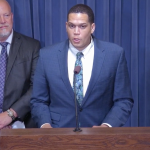
DPI’s Charlie Catlett on wastewater initiative with city of Chicago

A new initiative was announced last month between the city of Chicago and the University of Illinois Discovery Partners Institute to analyze wastewater in the city to potentially detect early outbreaks of COVID-19.
The two-year project will also help Chicago officials prioritize communities for enhanced COVID-19 testing or vaccination services.
Charlie Catlett, a senior research scientist at Discovery Partners Institute helping to lead on the initiative, recently spoke with Health News Illinois about the project and building off the statewide effort to analyze wastewater for potential COVID-19 outbreaks.
Edited excerpts are below.
HNI: How did this wastewater system initiative come to be?
CC: In the spring of 2020, we provided some seed funding to a science team at (University of Illinois Chicago), and people involved from Northwestern and Argonne and (University of Illinois Urbana-Champaign) as well. And then I joined that team because I had done quite a few projects with the city of Chicago and in other agencies. And what we did, as soon as we got the seed funding, is we wrote a proposal to a private foundation, the Walder Foundation, and got $1.25 million to do a prototype system to explore and test a way to monitor wastewater for a large city like Chicago. We wanted to determine: ‘What would be involved, what it would cost, would it be practical, how would you do it?’ And that led us to discussions with the Illinois Department of Public Health starting about a year ago, where we looked at how we would do the same thing, monitor wastewater for COVID trends, statewide. So we started a statewide project – this was the $5.5 million project started at the end of May last year. And then most recently, what happened was, we were at the end of our one-year research project where we had been monitoring Chicago as a research experiment, meeting with (Chicago Department of Public Health) every week and giving them the results. So from their point of view, it didn’t look like a research project but more like a service. So they said we want to keep this going for another two years. And so we worked out a way to do that to keep the project going and even expand a little bit on the work that we’ve done.
HNI: What can be learned from the past use of wastewater testing?
CC: So for COVID-19, it was anyone that was doing water analysis immediately determined that it would be useful to look for SARS-CoV-2 in wastewater, as soon as the pandemic broke, but certainly by spring of 2020, which is when we started looking at it. What we do with the wastewater is we take samples twice a week, and we extract using a laboratory process, we extract the RNA from that sample. The first thing we do is quantify using a PCR process, we quantify the amount of virus that’s in the water and that is measured in gene copies per volume of liquid. That concentration, we look at twice a week, and then we look at the trend over the previous two, four and eight weeks.
And from that, we can do two things. One is we can say, ‘Here’s the trend over the last two weeks. Here’s the trend over the last four weeks.’ But because we’re using mathematical tools to do this, those tools also give us a level of confidence. So we can say in our reports, for example, we’ll say, ‘This wastewater treatment plant looks like it has 30 percent increase over the last two weeks, and our confidence level in that number is 85 percent.’ The second thing that we do with a subset of the samples … We do genetic sequencing. And the purpose of doing genetic sequencing is that can give us an idea of what variants exist in the community. So those two things we do with these twice-weekly samples, and then we sit down with (Illinois Department of Public Health) every week and we talk with CDPH week, and then every other week we have an open briefing to anyone who’s interested from any of the local health departments throughout the state as well as any of our wastewater treatment plant partners.
HNI: How does this work with the statewide monitoring system for the Illinois Department of Public Health, as well as previous wastewater monitoring efforts in the city?
CC: Our project is the statewide system for wastewater. What IDPH and local health departments do is track health statistics, testing outcomes, hospitalizations and other things. When it comes to wastewater, we’re the ones that do that for them, and the same for the city of Chicago. There are a number of research projects around the country, and most of them we collaborate with, that are also analyzing water from Chicago. It’s a major city so everyone’s interested, and so for sequencing, there are a couple of labs that we know of that are doing sequencing from some of the Chicago samples. There are other labs that are doing quantification for Chicago, and all these labs, there are various methods for doing this. And so from our point of view, and there’s, it’s useful to try different ways to do it.
HNI: Are these efforts starting citywide?
CC: For large cities like Chicago, it’s not really sufficient to just do the treatment plants. You have to really go and find locations in the city itself where you can figure out what is the population served by this particular sampling point or this manhole. In Chicago, that’s particularly important because if you look at cities like Houston or Los Angeles or New York City, each of them has dozens of wastewater treatment plants, and so the largest of them, maybe would serve a half million people or a million. But the main plants that serve Chicago, the largest of them serves 2.3 million people. So if you look at a map of Chicago, there are three regions, the top region, the middle region and the south region, that’s how the treatment plants serve the city.
So if you’re looking for trends that are actionable for public health, like we’re seeing this part of the city that’s having a hotspot emerge. Well, you can’t really do that if you’re just looking at 2.3 million people and all you can say is it’s going up or down for the middle part of Chicago. So what we did was we used sewer modeling and sewer information, worked with the city and the Metropolitan Water Reclamation District to find – we’ve chosen eight locations within the city that are areas where we’ve seen particularly frequent hotspots. And so we are twice a week out pulling a manhole cover and getting a sample from these locations. And those locations, when we map out the communities served, the smallest community that we’re monitoring is 50,000 people, and the largest is 200,000. That’s really kind of the sweet spot for wastewater monitoring, a few tens of thousands of people is a good level of monitoring.
HNI: What are the signs you’re looking for as it relates to potential outbreaks?
CC: When a person is infected with COVID-19, they will begin to shed the virus in their waste, in their saliva, et cetera, almost from the onset of the disease. Even if they are symptomatic, they won’t know that they’re sick for two to four days. If they’re asymptomatic, they may never know that they’re sick. And so, when you look at hospitalizations and case numbers, what you’re looking at is cases that are at least four or five days old. Nobody goes to the hospital because they think they have COVID. They go because they have symptoms.
And so the reason for monitoring the trends in wastewater is that they will typically tell us about an increase or a decrease a week or so ahead of when we see that increase or decrease in the health statistic numbers … So the whole purpose for doing this is to get that trend in order to get that information into the hands of the local health departments for their planning purposes.
HNI: Is this process able to detect possible new strains or variants of the virus?
CC: So when omicron was identified, it was not long after that one particular variant was defined and identified that you could buy kits for the PCR system that would tell you what percentage of what you’re measuring is omicron versus delta, for example. And we finally got some of those kits in late December, and have been starting to develop the process where, at least for a known variant like omicron, we can quantify that in the PCR process without doing the genetic sequencing.
What genetic sequencing can do is tell us what variants are present. But because of the mechanics of the way sequencing works, it’s much more difficult to say what percentage we’re seeing. It’s not necessarily impossible, and we’re working on some methods that might allow us to do that. But sequencing wastewater is really sort of a tricky process. Sequencing wastewater and looking for a particular needle in that haystack and then looking for a particular variant of that needle, people told us two years ago or even a year and a half ago, they said you’re not likely to be able to do it. Or you can do it but it’s going to cost $10,000 to do a sample. We’re seeing some good success in identifying variants, but we’re still aren’t at the stage where we can say what percentage we’re seeing.









